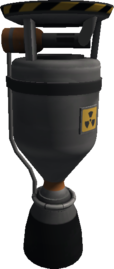Difference between revisions of "LV-N "Nerv" Atomic Rocket Motor"
(Implementation details to trivia) |
m (-removed author for description; *updated 1 description title;) |
||
| Line 10: | Line 10: | ||
It will [[overheating|overheat]] when run at full throttle, but it will usually stabilize before completely filling the overheat bar. As of version 0.23, it will quickly overheat and explode when placed directly under a [[Rockomax Jumbo-64 Fuel Tank]]. | It will [[overheating|overheat]] when run at full throttle, but it will usually stabilize before completely filling the overheat bar. As of version 0.23, it will quickly overheat and explode when placed directly under a [[Rockomax Jumbo-64 Fuel Tank]]. | ||
| − | == | + | == Product description == |
{{Quote | {{Quote | ||
|Despite the big scary trefoil painted onto the side of this engine, its radioactive exhaust, and tendency to overheat, the LV-N Atomic Rocket Motor is harmless. Mostly. | |Despite the big scary trefoil painted onto the side of this engine, its radioactive exhaust, and tendency to overheat, the LV-N Atomic Rocket Motor is harmless. Mostly. | ||
| − | + | }} | |
{{Quote|Yes, I know this is wrong. NTRs don't actually burn fuel and oxidizer, but we don't want to jump into making separate tanks for the two yet.|Excerpt from the part.cfg}} | {{Quote|Yes, I know this is wrong. NTRs don't actually burn fuel and oxidizer, but we don't want to jump into making separate tanks for the two yet.|Excerpt from the part.cfg}} | ||
Revision as of 16:52, 4 August 2014
| LV-N "Nerv" Atomic Rocket Motor | ||
| Liquid fuel engine by Jebediah Kerman's Junkyard and Spacecraft Parts Co | ||
| Radial size | Small | |
| Cost | (total) | 10 000.00 |
| Mass | (total) | 3.000 t |
| Drag | 0.2 | |
| Max. Temp. | 2500 K | |
| Impact Tolerance | 12 m/s | |
| Research | | |
| Unlock cost | 45 000 | |
| Since version | 0.17 | |
| Part configuration | liquidEngineLV-N.cfg | |
| Maximum thrust | (1 atm) | 13.88 kN |
| (vacuum) | 60.00 kN | |
| Isp | (1 atm) | 185 s |
| (vacuum) | 800 s | |
| Fuel consumption | 1.53 | |
| Thrust vectoring | No | |
| Electricity generated | 5.0 ⚡/s | |
| Testing Environments | ||
| On the surface | Yes | |
| In the ocean | No | |
| On the launchpad | No | |
| In the atmosphere | Yes | |
| Sub-orbital | Yes | |
| In an orbit | Yes | |
| On an escape | Yes | |
| Docked | No | |
| Test by staging | Yes | |
| Manually testable | Yes | |
The LV-N Atomic Rocket Motor is a low-thrust, high-efficiency rocket engine. It is modeled after the real-world nuclear thermal rocket, which uses a fission reactor to heat its propellant and force it out of the rocket nozzle to generate thrust (as opposed to a normal rocket, which ignites the propellant and uses the energy released by the resulting chemical reaction for that purpose).
Contents
Usage
The LV-N has low thrust and a very high mass, giving it the worst thrust-to-weight ratio of all liquid engines. Its Isp while in atmosphere is also quite poor, making it not recommended for operation within atmospheres or for landings on larger bodies.
However, when outside the atmosphere, its efficiency becomes superb with a vacuum Isp of 800 s, by far the highest of any liquid fuel engine. This remarkable efficiency makes it quite popular for upper stages as it is ideal for interplanetary travel.
It will overheat when run at full throttle, but it will usually stabilize before completely filling the overheat bar. As of version 0.23, it will quickly overheat and explode when placed directly under a Rockomax Jumbo-64 Fuel Tank.
Product description
| “ | Despite the big scary trefoil painted onto the side of this engine, its radioactive exhaust, and tendency to overheat, the LV-N Atomic Rocket Motor is harmless. Mostly. | ” |
| “ | Yes, I know this is wrong. NTRs don't actually burn fuel and oxidizer, but we don't want to jump into making separate tanks for the two yet. — Excerpt from the part.cfg |
” |
Trivia
- The description of this part is a reference to the Douglas Adams humorous sci-fi novel "Mostly Harmless"
- Unlike real-world nuclear thermal rockets, the LV-N consumes both liquid fuel and oxidizer. This due to programming constraints, as stated in its parts.cfg file, and Squad's unwillingness to add another propellant type. Real NTRs run on liquid hydrogen, but are capable of using other propellants at lower efficiencies.
Changes
- Cost increased from 1700 to 8700 (and made meaningful)
- Alternator added, engine now gains 5.0 electricity.
- Initial release
